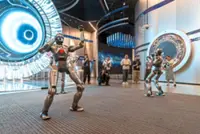Mia Qu, third from right, a second-year student at the University of Washington Law School, gasps in delight after making Spot, pick up a cup during the We Robot 2022 conference. — The Seattle Times/TNS
There is the Hollywood version of AI robots — the "AI" stands for "artificial intelligence" — that has given us the scary future depicted in the Terminator, Matrix, and RoboCop movies.
But at a gathering of lawyers and roboticists last week at the University of Washington, you could see the actual status of AI robots.
Already a subscriber? Log in
Save 30% OFF The Star Digital Access
Cancel anytime. Ad-free. Unlimited access with perks.





